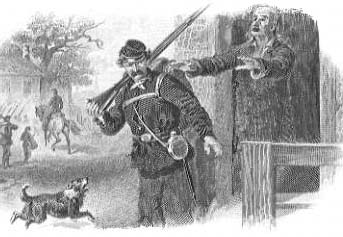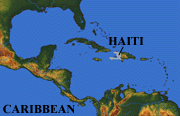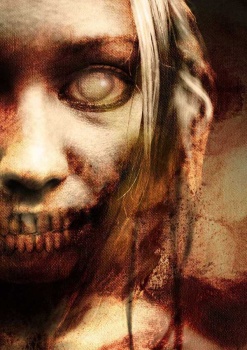The Top Three Zombie Outbreaks in U.S. History
Like vampires, zombies are great opportunists. So it comes as no surprise that zombie outbreaks often happen in the wake of natural disasters. Combine disasters with warm climates and you truly have a recipe for a major outbreak, as the following stories prove.
Key West, Florida, 1935
 |
Key West, 1935: Zombie
bodies prepared for disposal |
On Labor Day, September 2, 1935, a major hurricane bore down on the Florida Keys, a string of islands separating the Gulf of Mexico from the Atlantic Ocean. The hurricane, one of only two Category 5 storms ever recorded in the United States, made landfall at Key West, the most populous of the keys. As day turned to night, heavy rains and winds of over 150 miles an hour rolled over the island, destroying virtually everything standing. Amid the destruction, infected rats began roaming the island, and by morning, the first of the zombies appeared. Many islanders mistook the zombies for dazed hurricane survivors and the plague spread across the island like wildfire. To make matters worse, the roads and bridges connecting the keys to the mainland had been washed out by the storm. The islanders had no way to escape. Scores of people drowned when they chose to leap into the choppy surf rather than face the voracious zombies.
Within days, FVZA troops from all over the south converged on Key West in a variety of sea craft. They established a beachhead on the south side of the island and went about the process of extermination. It took three weeks to secure the island. A total of 3500 people were infected and destroyed, an enormous number considering that there was a zombie vaccine available at this time.
Vicksburg, Mississippi, 1863
!863 was the pivotal year of the American Civil War. The Union army, sensing victory, tried to deal a knockout blow to the Confederacy by taking control of the Mississippi River. After New Orleans fell to the Union, the city of Vicksburg remained as the last Confederate holdout on the big river. On May 18, 1963, 3200 Union troops arrived off the coast of Vicksburg and demanded an immediate surrender. But Confederate leaders refused, and the Union laid seige to the city. A month of heavy bombardment ensued.
 |
A zombie attacks a Union
soldier in Vicksburg |
On June 17, city residents spotted the first zombie, and within days, dozens were wandering about. This development hardly worried the 30,000 Confederate troops protecting the city; they entertained themselves by conducting target practice on the zombies. But with their supply lines cut off, the Confederate troops soon ran out of ammunition, and the zombies kept coming. To this day, Southerners claim that the Union let the zombie plague continue out of pure malice. In any case, when Union forces entered the city on July 3, hundreds of zombies were roaming the streets, many in Confederate Army uniforms. As there was no FVZA at this time, the Union soldiers had to do the killing and they quickly found out that zombies, unlike soldiers, do not surrender. In the end, an estimated 2000 people were infected and destroyed at Vicksburg, almost as many as were killed in the Battle of Bull Run.
Hawaii, 1892
 |
| Queen Lili’uokalani |
At the beginning of the 1890s, Hawaii found itself in a tug of war between native islanders, who wanted the islands to remain independent, and powerful sugar growers who wanted to join the United States. Queen Lili’uokalani ascended to the throne in 1891 and promptly enacted a series of measures designed to weaken the influence of the sugar growers. However, her mind was soon occupied by different matters: in August of 1892, a zombie plague that had begun among Chinese laborers in the sugar cane fields of Oahu spread to Honolulu. Wave after wave of zombies came staggering out of the jungle, forcing desperate islanders to board outrigger canoes and flee to neighboring islands.
Despite her fear of losing independence, the Queen had no choice but to ask the United States for help. A detachment of FVZA troops arrived in the fall and quickly wrested control of the city from the zombies. But the surrounding countryside proved more difficult to clear, and more FVZA agents were called in. The sugar growers took advantage of the chaos and panic by launching a coup, and the Queen was deposed. Hawaii was annexed by the United States in 1898.
There has long been suspicion that the sugar growers let the plague go in order to destabilize the queen, a suspicion strengthened by the fact that the top growers left Hawaii shortly after the outbreak began. Whatever the case, Hawaii’s 1893 zombie outbreak killed just under 2000 people, making it the third-worst in U.S. history.
http://www.fvza.org/topthree.html
Where do zombies come from? Here’s a little lesson in Zombie History.
Zombie History and Haitian Folklore
The origin of the concept of zombiism stems from Haitian Voodoo culture. The word zombie–in Haitian it is “zombi”–means “spirit of the dead.” Voodoo folklore contends that Bokors, Voodoo priests that were concerned with the study and application of black magic, posessed the ability to ressurrect the deceased through the administration of coup padre–coup padre is a powder that is issued orally, the primary ingredient of which is tetrodoxin, the deadly substance of the notoriously poisonous fou-fou, or “porcupine fish.” According to lengend, “a zombi(e) is someone who has annoyed his or her family and community to the degree that they can no longer stand to live with this person. They respond by hiring a Bokor..to turn them into a zombi(e).” (Keegan, www.flmnh.ufl.edu)
Once they had been issued the coup padre, the subjects being prepared for their descent into zombidom would appear to die insofar as their heart rate would slow to a near stop, their breathing patterns would be greatly subdued and their body temperature would significantly decrease. The public, thinking that the person was dead, would bury him/ her as if they were a corpse. They would then be exhumed, still alive, by the Bokor and, although their physicality remained intact, their memory would be erased and they would be transformed into mindless drones. “Though still living, they remain under the Bokor’s power until the Bokor dies.” (Keegan, www.flmnh.ufl.edu)
Source: http://www.umich.edu/~engl415/zombies/zombie.html





